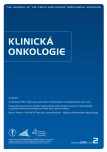Quality of Life After High-dose Brachytherapy in Patients with Early Oral Carcinoma
Authors:
Doležalová Helena 1; Blechová Nicole 2; Petera Jiří 3
Authors‘ workplace:
Stomatologická klinika LF UK a FN Hradec Králové
1; Radiologická klinika LF UK a FN Hradec Králové
2; Klinika onkologie a radioterapie LF UK a FN Hradec Králové
3
Published in:
Klin Onkol 2018; 31(2): 125-129
Category:
Original Articles
doi:
https://doi.org/10.14735/amko2018125
Overview
Background:
The prevalence of head and neck tumors has continually increased over the past decades, which is a serious medical and social problem. This study retrospectively assessed the quality of life of patients with early-stage oral cavity tumors after high-dose rate (HDR) brachytherapy.
Material and Methods:
Quality of life was evaluated in 14 patients with early-onset oral cavity tumors who underwent HDR brachytherapy at the Department of Oncology and Radiotherapy, University Hospital Hradec Kralove. The standardized EORTC QLQ-C30 and EORTC QLQ-H&N 35 questionnaires were used. Patients completed these questionnaires at 12 months after treatment.
Results:
The general health status was scored 70 points using the EORTC QLQ-C30 questionnaire. Fatigue, insomnia, loss of appetite, dyspnea, and financial problems were the most severe problems reported. The main problems identified by the EORTC QLQ-H&N 35 questionnaire were weight gain, coughing, pain, sticky saliva, and difficulties eating in public. On the contrary, patients did not significantly suffer weight loss, speech impairments, difficulties in mouth opening or swallowing, or sensory problems.
Conclusion:
HDR brachytherapy is an effective treatment for early oral cancer that leaves patients with an acceptable quality of life. A prospective, multicentric study focused on the quality of life of patients with head and neck tumors is required.
Key worlds:
oral cancer – brachytherapy – quality of life
This article was supported by grant PROGRES Q 40/13.
The authors declare they have no potential conflicts of interest concerning drugs, products, or services used in the study.
The Editorial Board declares that the manuscript met the ICMJE recommendation for biomedical papers.
Submitted:
17. 1. 2018
Accepted:
4. 2. 2018
Sources
1. Grabenbauer GG, Rödel C, Brunner T et al. Interstitial brachytherapy with Ir-192 low-dose-rate in the treatment of primary and recurrent cancer of the oral cavity and oropharynx. Strahlenther Onkol 2001; 177 (7): 338–344.
2. Mazeron JJ, Ardiet JM, Haie-Méder C et al. GEC-ESTRO recommendations for brachytherapy for head and neck squamous cell carcinomas. Radiother Oncol 2009; 91 (2): 150–156. doi: 10.1016/j.radonc.2009.01.005.
3. Lapeyre M, Hoffstetter S, Peifert D et al. Postoperative brachytherapy alone for T1-2 N0 squamous cell carcinomas of the oral tongue and floor or mouth with close or positive margins. Int J Radiat Oncol Biol Phys 2000; 48 (1): 37–42.
4. Petera J, Sirák I, Laco J et al. High dose rate brachytherapy in early oral cancer with close of positive margins. Brachytherapy 2015; 14 (1): 77–83. doi: 10.1016/j.brachy.2014.08.050.
5. Malá E, Vejražková E, Bielmeierová J et al. Dlouhodobé sledování nutričního, klinického stavu a kvality života u nemocných s rakovinou hlavy a krku. Klin Onkol 2015; 28 (3): 200–214. doi: 10.14735/amko2015200.
6. Yoshimura RI, Shibuya H, Miura M et al. Quality of life in oral cancer patients after low dose rate interstitial brachytherapy. Int J Radiat Oncol BiolPhys 2009; 73 (3): 772–778.
7. Petera J, Matula P, Paluska P et al. High dose rate versus low dose rate brachytherapy in the treatment of tongue carcinoma: a radiobiology study. Neoplasma 2009; 56: 163–168. doi: 10.1016/j.ijrobp.2008.05.001.
8. Inoue T, Inoue T, Yoshida K et al. Phase III trial of high-vs. low-dose-rate interstitial radiotherapy for early mobile tongue cancer. Int J Radiat Oncol Biol Phys 2001; 51 (1): 171–175.
9. Schliephake H, Jamil MU. Prospective evaluation of quality of life after oncologic surgery for oral cancer. Int J Oral Maxillofac Surg 2002; 31 (4): 427–433. doi: 10.1054/ijom.2001.0194.
10. Klug C, Neuburg J, Glaser C et al. Quality of life 2–10 years after combined treatment for advanced oral and oropharyngeal cancer. Int J Oral Maxillofac Surg 2002; 31 (6): 664–669. doi: 10.1054/ijom.2002.0301.
Labels
Paediatric clinical oncology Surgery Clinical oncologyArticle was published in
Clinical Oncology

2018 Issue 2
- Metamizole vs. Tramadol in Postoperative Analgesia
- Metamizole at a Glance and in Practice – Effective Non-Opioid Analgesic for All Ages
- Possibilities of Using Metamizole in the Treatment of Acute Primary Headaches
- Current Insights into the Antispasmodic and Analgesic Effects of Metamizole on the Gastrointestinal Tract
- Spasmolytic Effect of Metamizole
Most read in this issue
- Cutaneous and Subcutaneous Metastases of Adenocarcinoma as a Dominant Clinical Manifestation of Malignancy of Unknown Origin – a Case Report
- Long Non-coding RNAs as Regulators of the Mitogen-activated Protein Kinase (MAPK) Pathway in Cancer
- MAPK/ERK signal pathway alterations in patients with Langerhans Cell Histiocytosis
- Human Papillomavirus – Role in Cervical Carcinogenesis and Methods of Detection
